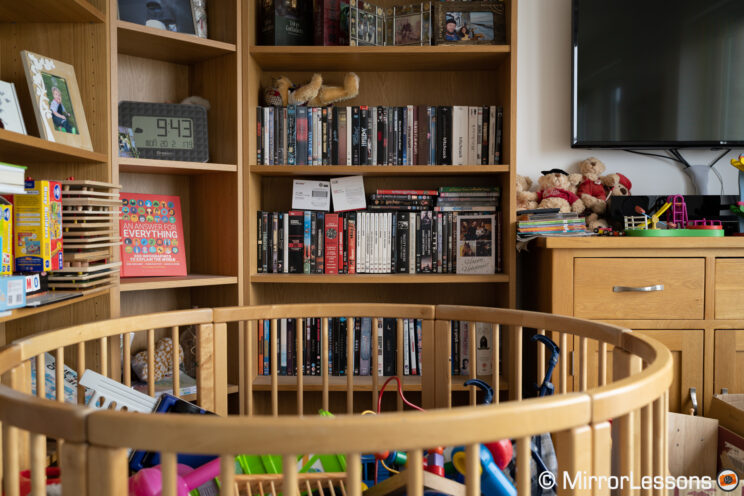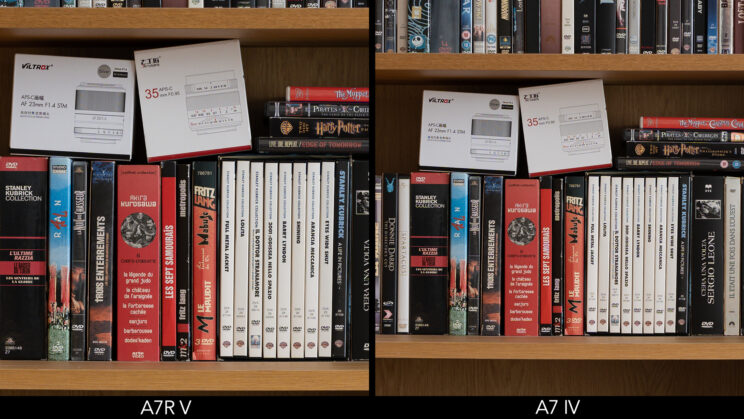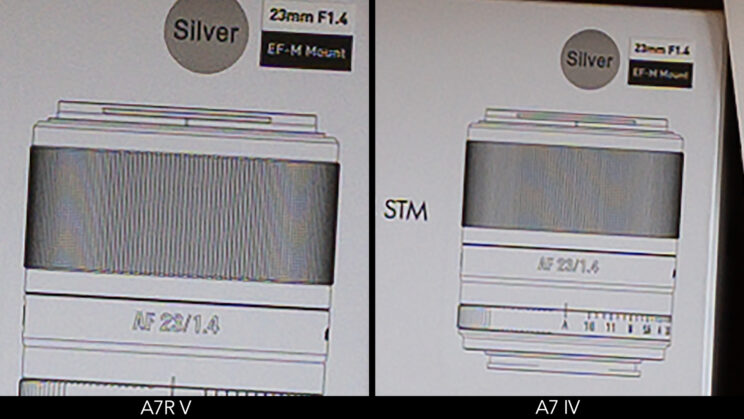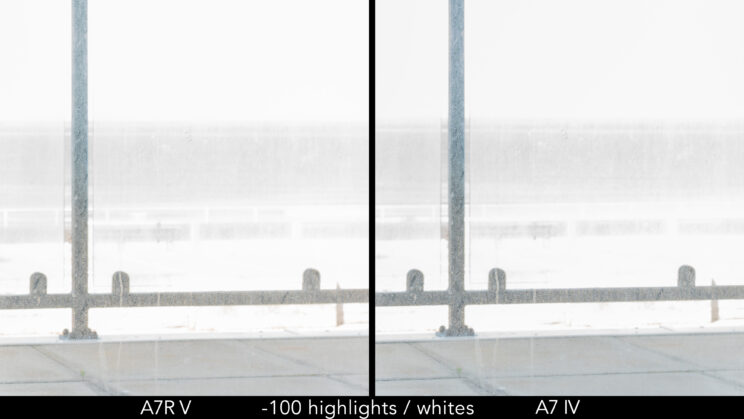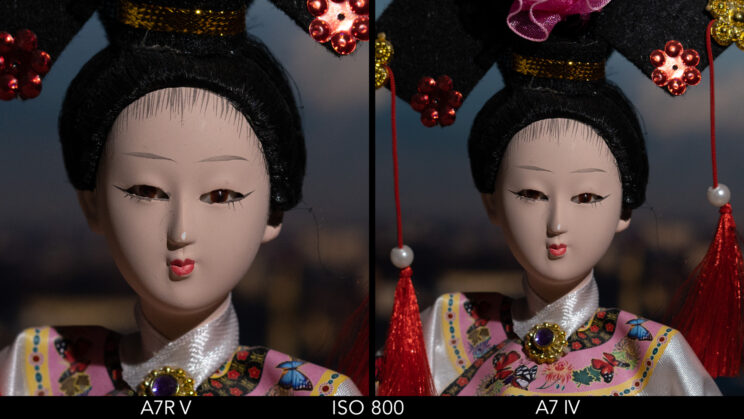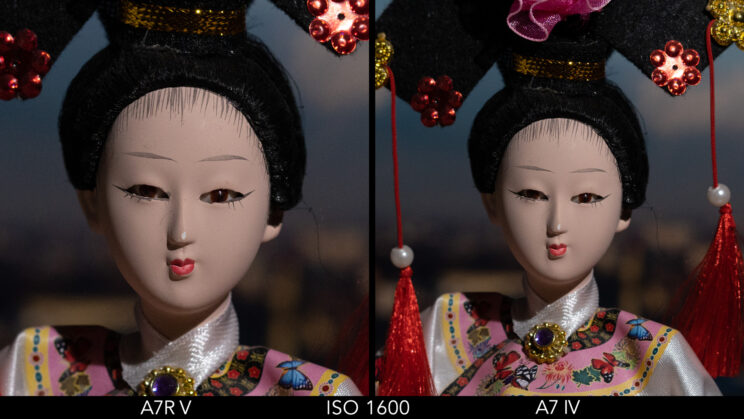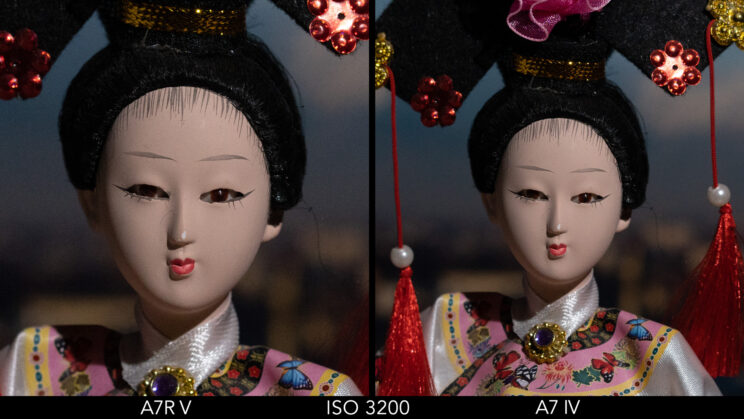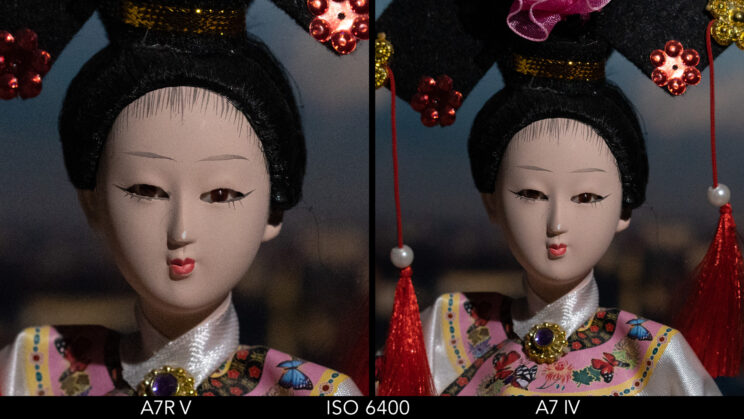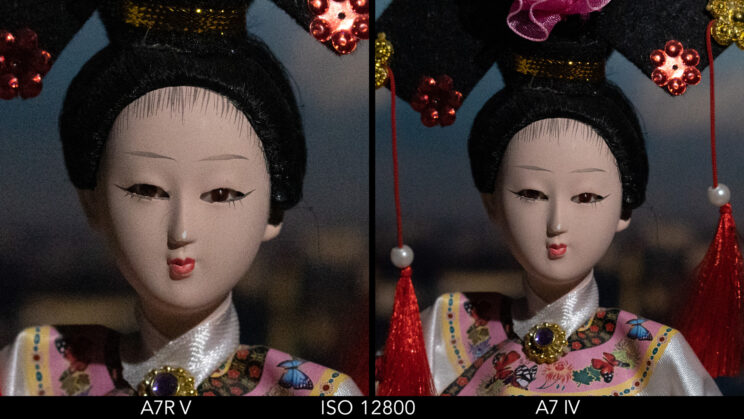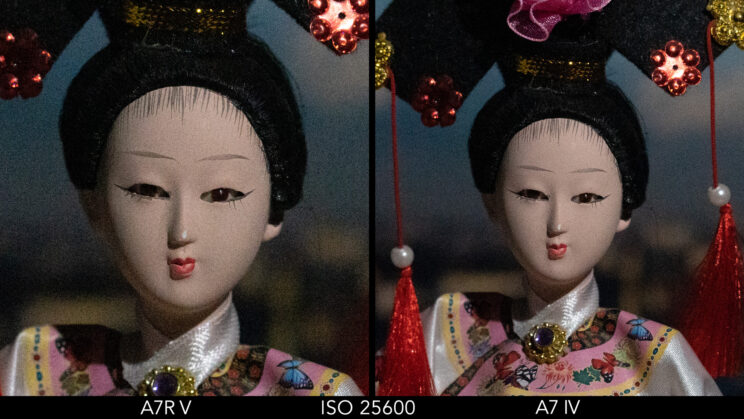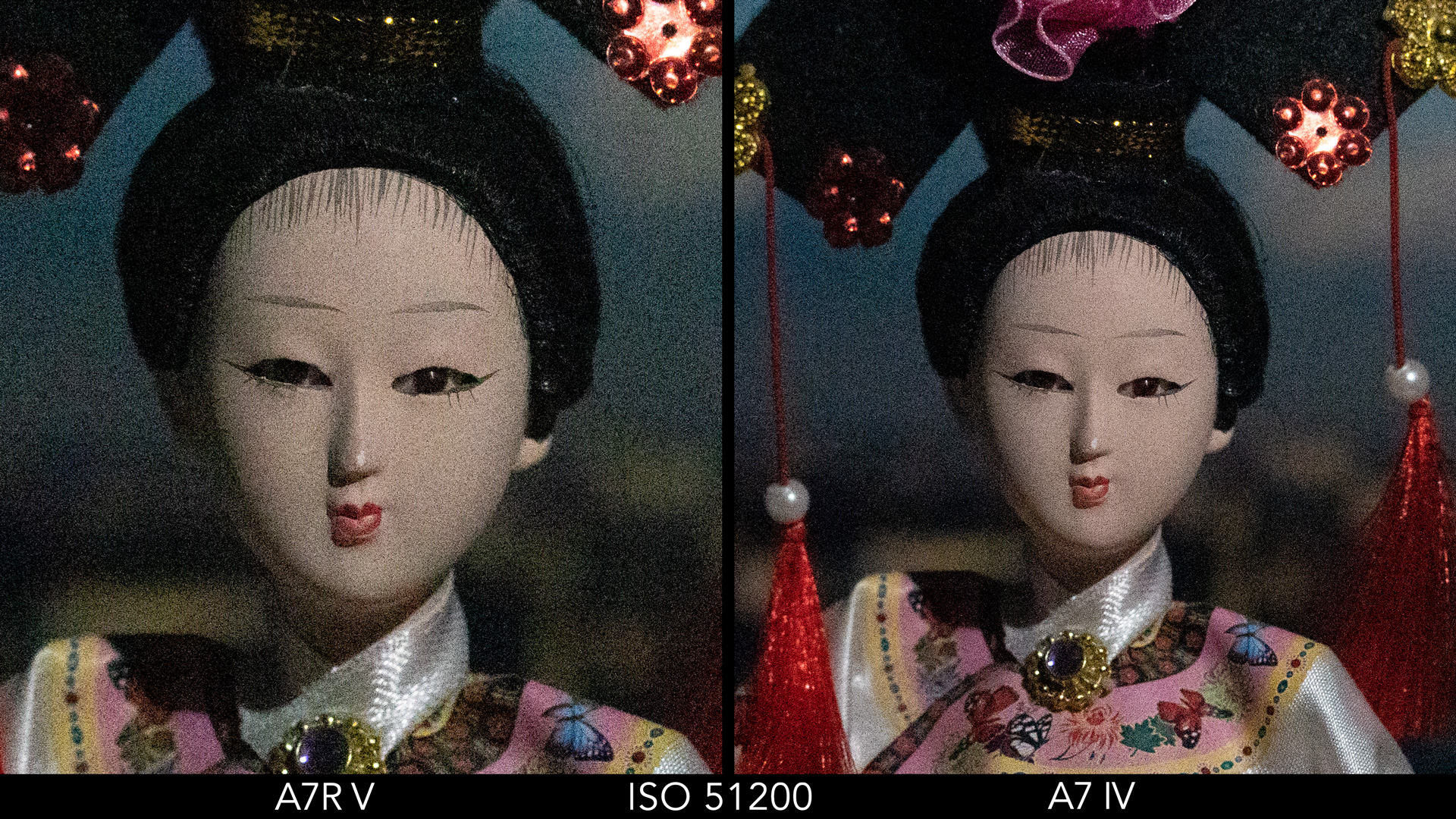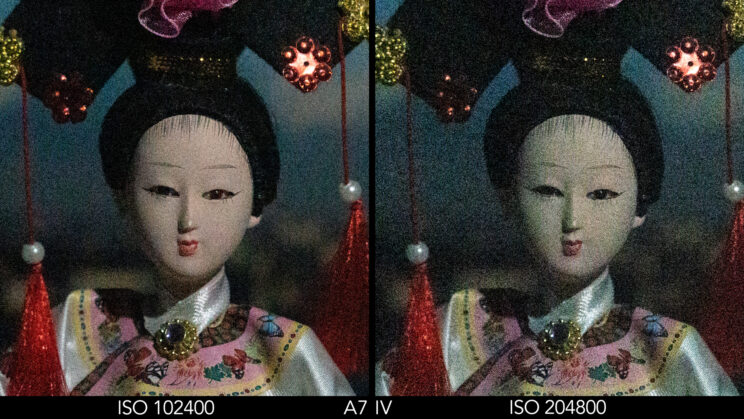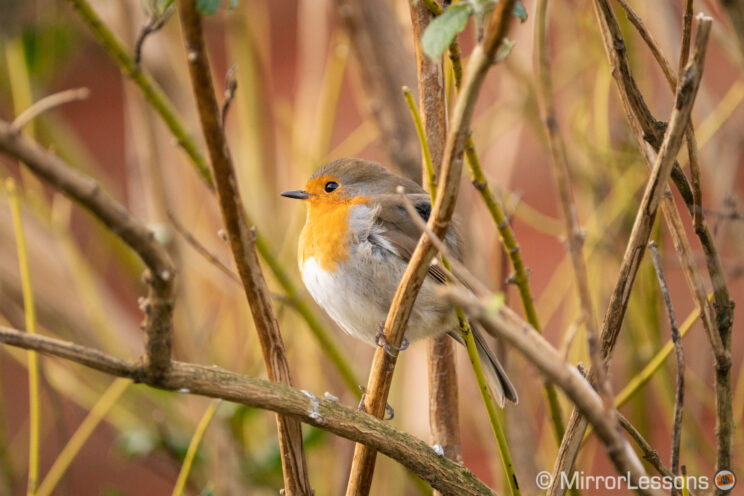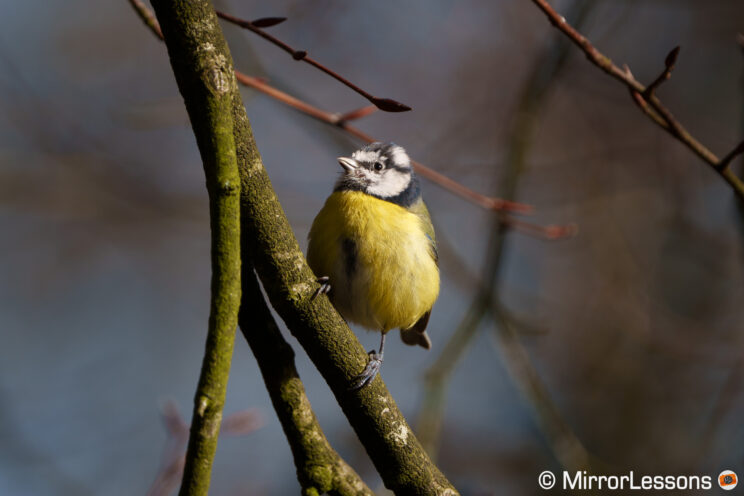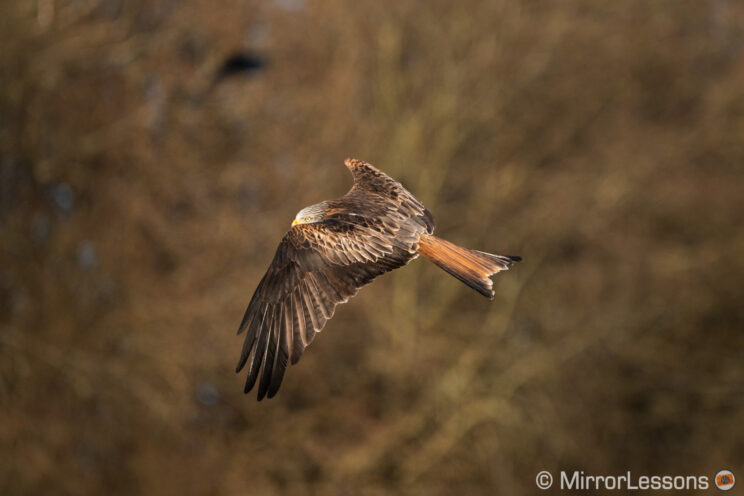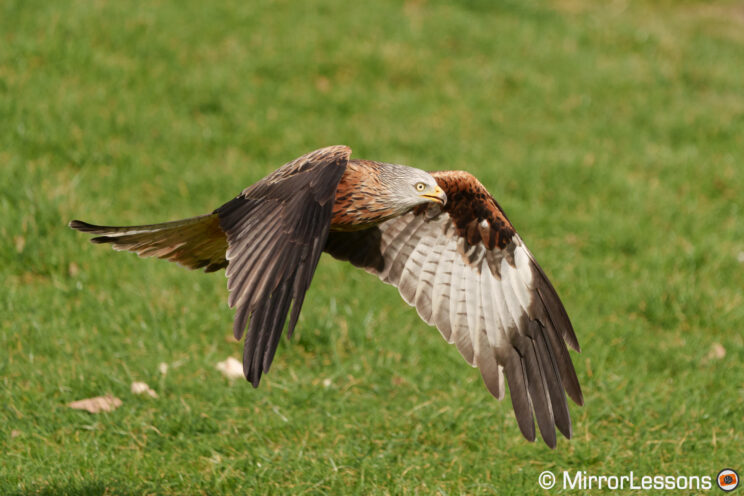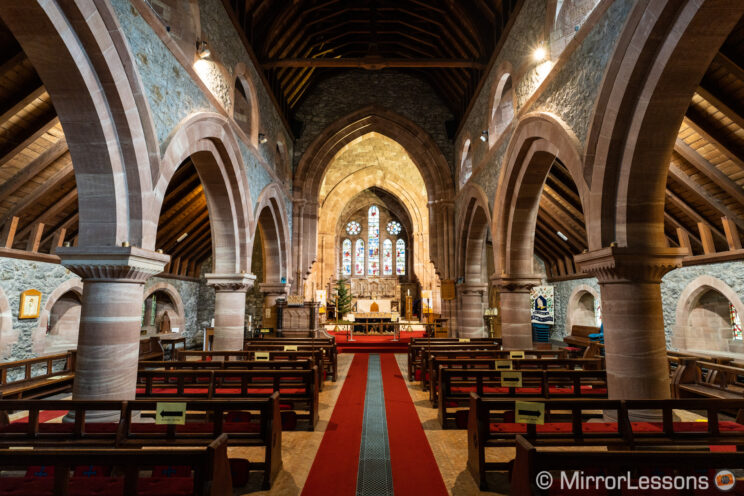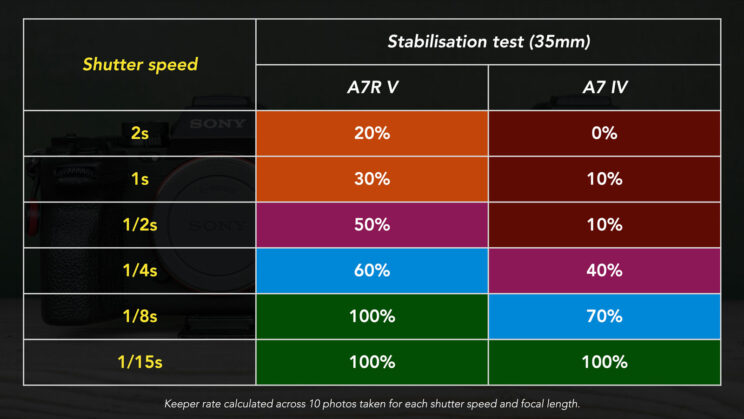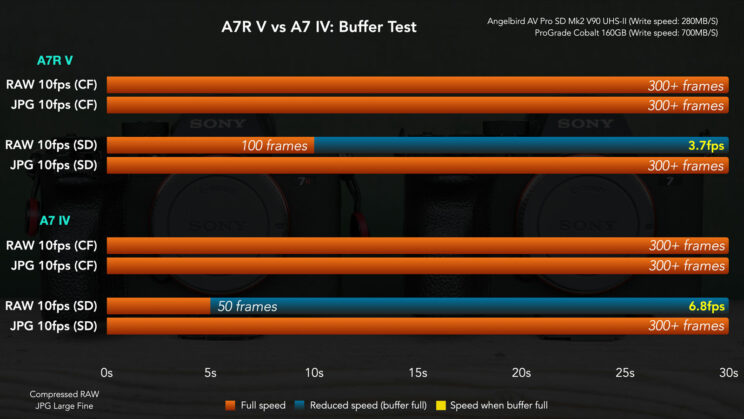Over a year ago, Sony introduced the Sony Alpha a7 IV, an impressive 33MP camera marketed to pros and enthusiasts. Fast forward a year, and now photographers and cinematographers have a newly implemented 61MP Sony a7R V camera to consider.
In this Sony a7 IV vs Sony a7R V comparison, we dive deep into the main differences you’ll find when comparing these two bodies. By the end of this guide, you should clearly understand which camera is right for you based on the type of photos or videos you capture. So without further ado, let’s dive in.
Note: the original preview was written by Leigh Diprose. The article has then been updated by Mathieu Gasquet, following his direct experience with these two cameras.
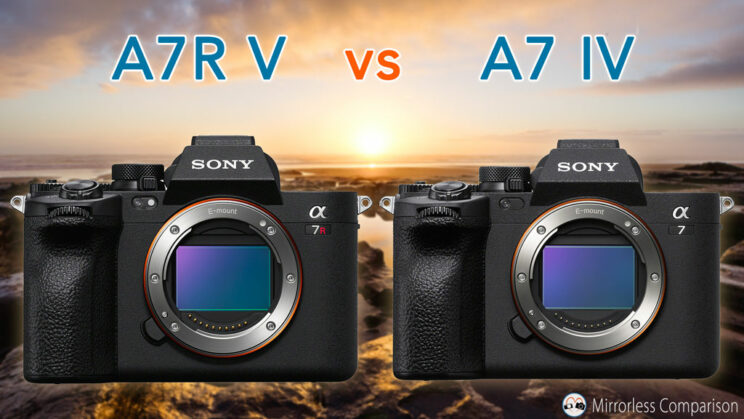
Ethics statement: the following is based on our personal experience with the A7R V and A7 IV. We were not asked to write anything about this product, nor were we provided any compensation of any kind. Within the article, there are affiliate links. If you buy something after clicking one of these links, we will receive a small commission. To know more about our ethics, you can visit our full disclosure page. Thank you!
TABLE OF CONTENTS
Main Specs
1. Sensor
2. Image Processor
3. Autofocus
4. Stabilisation
5. Movie Output
6. LCD and EVF
7. Camera Operation
8. Storage and Buffer
9. Connectivity and Workflow
10. Price
Conclusion
Main Specs
A7 IV
- Sensor: 33.0MP 35mm format BSI Exmor R CMOS
- Lens system: E-mount
- Weatherproof: Yes
- Internal Stabilisation: Yes (5-axis), 5.5 stops
- Autofocus: Hybrid with 759 phase and 425 contrast detection points, Subject Detection (People, Animals, Birds)
- Continuous shooting: 3fps to 10fps
- ISO Sensitivity: 100 – 51,200 ISO (pull 50, push up to 204,800)
- Shutter Speeds: 1/8,000 to 30s, Bulb
- Viewfinder: 0.5in OLED with 3.69M dots, 23mm eye point, 0.78x magnification and 120fps refresh rate
- Rear monitor: Multi-angle 3″ LCD (1.04M dots) with touch sensitivity
- Movie recording: 4K up to 60fps, Full HD up to 120fps, 10-bit 4:2:2 internal, S-Log, S-Cinetone and HLG gamma
- Built-in Flash: No
- Extra Features: WiFi, Bluetooth, Bracketing, Intervalometer, Wifi, Tethering, USB streaming, Dual SD slots
- Dimensions: 131.3 x 96.4 x 79.8mm
- Weight: 658g (including battery and memory card)
- Firmware version: 2.00
- Release: 2021
A7R V
- Sensor: 61.0MP 35mm format BSI Exmor R CMOS
- Lens system: E-mount
- Weatherproof: Yes
- Internal Stabilisation: Yes (5-axis), 8 stops
- Autofocus: Hybrid with 693 phase and 25 contrast detection points, Subject Detection (People, Animals, Birds, Insects, Vehicles)
- Continuous shooting: 3fps to 10fps
- ISO Sensitivity: 100 – 32,000 ISO (pull 50, push up to 102,400)
- Shutter Speeds: 1/8,000 to 30s, Bulb
- Viewfinder: 0.64in OLED with 9.44M dots, 25mm eye point, 0.90x magnification and 120fps refresh rate
- Rear monitor: 4 axis 3.2″ LCD (2.1M dots) with touch sensitivity
- Movie recording: 8K 25p, 4K up to 60p, Full HD up to 120fps, 10-bit 4:2:2 internal, S-Log, S-Cinetone and HLG gamma
- Built-in Flash: No
- Extra Features: WiFi, Bluetooth, Bracketing, Intervalometer, Wifi, Tethering, USB streaming, Dual CFexpress/SD slots
- Dimensions: 131.3 x 96.4 x 79.8mm
- Weight: 658g (including battery and memory card)
- Firmware version: 2.00
- Release: 2021
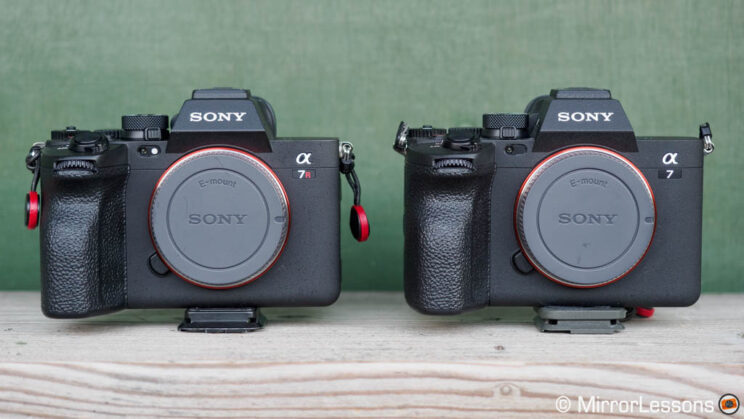
1. Sensor
While the sensor size is identical on the two cameras (35mm format, aka full frame), the a7R V features a jaw dropping 61MP sensor, almost double the resolution found in the a7 IV (33MP).
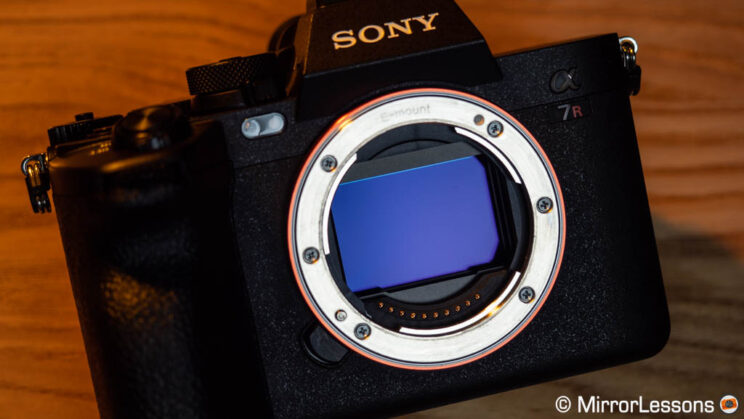
Both sensors are built around a back-side illuminated structure. The R model lacks the low pass filter to maximise sharpness, whereas we believe the A7 IV has a weak AA filter after making side by side tests with other cameras.
In the our first scene below, you can appreciate the extra magnification and crisp details produced by the R model, when pixel peeping at 100% magnification.
Both can produce a bit of moiré, such as when very thin lines are close to each other. The same can happen on fabric, but it is usually easy to remove in post.
Regarding dynamic range, I didn’t notice any difference compared to my previous work done with the same sensors (A7 IV vs A7R IV). Both perform admirably in terms of shadow recovery, and the preservation of highlight details is identical. If I were to nitpick, I could mention that the image from the A7R V exhibits a slight color cast around the stuffed toy animal, but it’s hardly a concern.

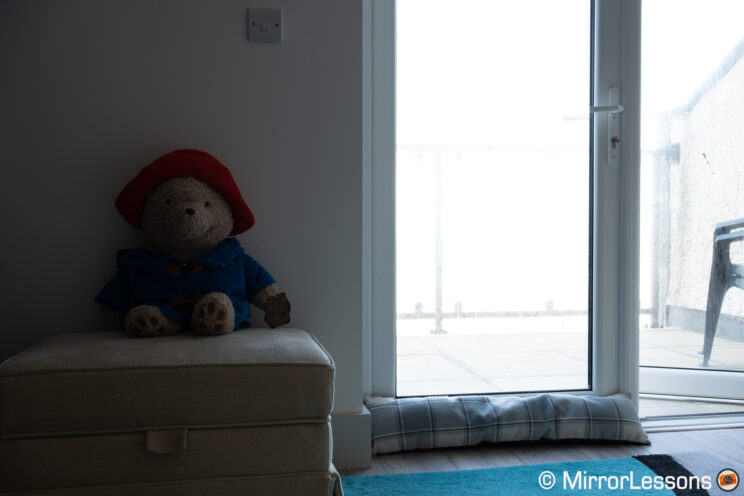
Where the A7 IV gains something is with the ISO sensitivity: the 33MP camera has a range of 100 to 51,200 (normal), which can extend to ISO 50 and ISO 204,800.
The A7R V is not far off: ISO 100-32,000, or ISO 50-102,400 with the extended values.
I find the A7R V to be highly capable when it comes to handling high ISO photographs, especially considering its resolution. Up to 12,800, the difference is minimal. However, the R model starts to struggle at ISO 25,600, where noise becomes more noticeable. On the other hand, the A7 IV remains reasonably usable even up to 51,200.
2. Image Processor
The image processor is often overlooked, but it plays a much more important role than we’d like to believe. This is certainly the case with the Sony a7R V, where Sony pushes the concept further.
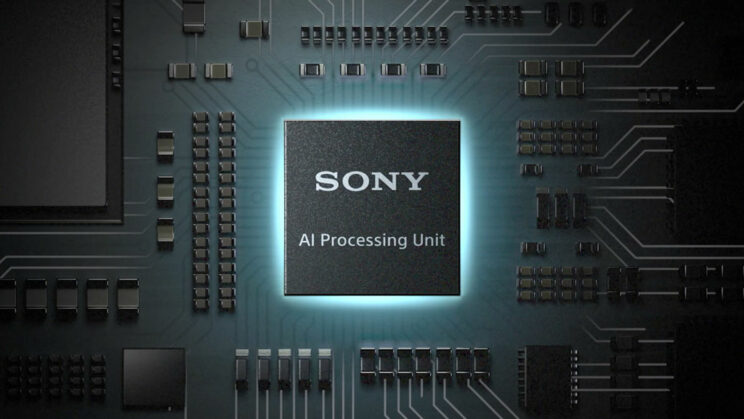
The fancy new AI processing unit of the A7R V talks between the 61MP sensor and BIONZ XR processing engine brings a series of enhacements through advanced algorithms, resulting in more precise image stabilisation and improved auto white balance accuracy (also thanks to the visible/IR sensor on the front of the camera).
But the biggest divide the AI chip creates is the advanced subject autofocus recognition that I’m describing in the next chapter.
3. Autofocus Comparison
The Sony a7 IV has always been an excellent camera when utilising autofocus on various subjects. Driven by 759 Phase-Detection Focal Plane Autofocus points, the camera locks focus precisely without hunting. When comparing it against the newer model, which includes 693 Phase-Detection points, you might think the a7 IV outperforms. However, there is more to this story.
The Sony a7 IV will allow you to track Humans, Animals and Birds well, as shown on this website with various tests and reviews; however, there is a relevant improvement regarding the same setting on the Sony a7R V. The AI processing unit assists the focus system through intelligent algorithms to predict body poses and track not only the eye, but also the head and body.
According to Sony, the a7R V improves the focus tracking of Humans by 60% and Animals / Birds by 40% compared to the a7 IV.
This same algorithm can also track other subjects as well. For instance, using the head and body tracking combination, insects are easily identifiable. In addition to insects, the A7R V will track Cars, Trains and Aeroplanes.
Subject Detection
a7 IV
a7R V
Humans
Face / Eyes
Face, Head, Eyes, Body (with pose estimation)
Animals
Eyes
Body, Head, Eyes
Birds
Eyes
Body, Head, Eyes
Insects
–
Yes
Trains
–
Yes
Airplanes
–
Yes
Cars
–
Yes
Due to my limited time with the A7R V, I wasn’t able to test its autofocus performance across all subject types. However, I can provide feedback regarding birds.
When it comes to static animals, particularly small birds situated in distant trees, facing away, or in close proximity to branches and leaves that would typically cause confusion with the AF, the A7R V excels. It consistently recognizes the presence of a bird in the frame, making tracking easier and more accurate than ever before, even in challenging situations.
When it came to capturing birds in flight, the A7R V fell short and proved to be a bit disappointing. Despite experimenting with various settings combinations and revisiting the same location multiple times, I couldn’t achieve a better performance compared to its predecessor, the A7R IV. In this regard, the A7 IV outperforms the A7R V.
A7 IV
94%
100%
A7R IV
88%
100%
A7R V
84%
97%
Note: green means perfectly sharp images only, blue also includes slightly soft results. Find out more about this in my birds in flight main article.
My impression is that the AI algorithm tries too hard, resulting in a loss of focus accuracy. In fact, the performance without subject detection was similar, indicating that the advanced “Bird AF” doesn’t make a significant difference in this particular context.
Furthermore, setting up the camera has become more challenging. Sony has introduced additional settings to control the behavior of the subject detection mode, but they are initially difficult to comprehend and will require patience to understand their functionality and appropriate usage. Sony E-mount cameras, including the A7 IV, have always been among the most user-friendly to setup, but the R model is the complete opposite in this regard. For a more detailed exploration of this topic, please check out my dedicated A7R V review for bird photography.
Changing genre, macro photographers will be pleased to know they can now bracket up to 299 images, sequentially shifting your point while capturing, using the a7R V. The images cannot be composited in camera, but on your computer via the Sony Imaging Edge software.
Finally, the low light rating is the same for both cameras: EV -4.0 at an equivalent ISO 100 and F2 aperture.
4. Stabilisation Improvements
You’ll find a vast improvement on the Sony a7R V. Now, with a better 5-axis in-body image stabilisation system, photographers gain 8-steps of compensation. Compared to the a7 IV’s 5.5-steps, this is the leap forward Sony users have been waiting for (Sony’s stabilisation has been the weakest part of the system so far).
The newer system works via a high-performance gyro sensor which can utilise the AI processing unit’s algorithm to detect and compensate for the blur on a single pixel level!
I tested the two cameras using the same lens (FE 35mm GM) and aimed to push them to their limits in terms of slow shutter speeds. For each exposure time, I captured 10 pictures and analyzed the keeper rate, which indicates how many photos were acceptably sharp versus those with excessive motion blur.
The results are displayed below. Despite the relatively low keeper rate, it is remarkable that the A7R V can handle shutter speeds as slow as 1 second, or even two seconds, while being used handheld. On the other hand, the A7 IV struggles until you select a speed of 1/4s or faster.
If you plan on using the a7R V for video, you’ll find slight stabilisation enhancements on the new model.
The Active mode is available on both cameras (unless if you are shooting 8K with the R model), but the A7R V has a newly released stabilisation algorithm that works with select OSS lenses to gain better stabilised footage. These lenses include 24-105mm F4, 70-200mm GM, 100-400mm GM, and 200-600mm G, although to unlock this feature, you need to update the lens software.
I conducted a quick test using my FE 200-600mm lens and recorded footage with both the standard SteadyShot and the Active mode. Personally, I did not notice a significant difference between the two. The A7R V does seem slightly more stable when using the Standard mode at 600mm, but the Active mode performs similarly.
We must not forget that the 5-axis sensor shift inside the a7R V can be used for another function: the Pixel Shift Multi Shooting mode, that can output the same 61MP files with enhanced colour resolution (4 frames) or an impressive 240MP output (combining 16 frames).
One limitation of this feature is that small movements that happen inside the scene lead to artefacts. This is where the major improvement comes on the A7R V: small movements can be corrected when the files are processed with the latest version of Sony’s Imaging Edge software (you cannot do this in camera unfortunately).
5. Differences and Similarities In Movie Output
The main difference is found with the a7R V, which is capable of recording 8K at 24p or 25p (albeit with a 1.24x crop). This impressive quality can be maintained internally within the camera at 10-bit 4:2:0 for half an hour. To achieve this long duration, Sony’s solution has been to include the same heat disspitation structure found in the A7S III and A7 IV.
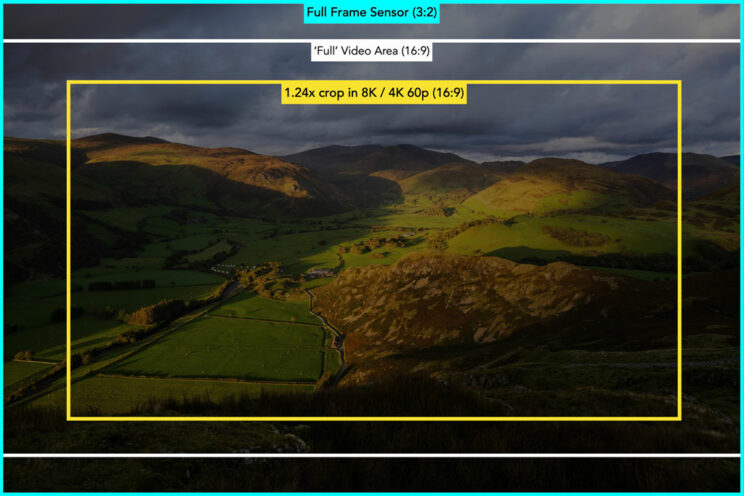
In comparison, the highest output the Sony a7 IV provides is the matched spec of the a7R V at 4K 60p. However, the a7 IV can record this with the Super35 mode only (aka 1.5x APS-C crop), whereas the a7R V does a bit better with a 1.24x crop again.
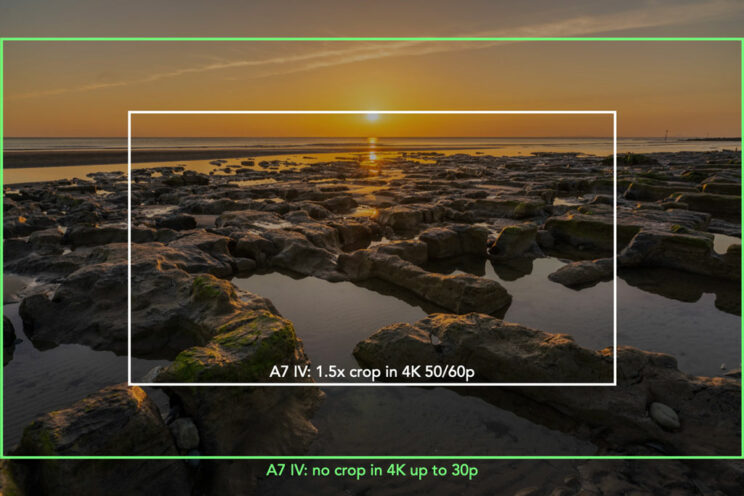
It is important to note that when recording in 4K 50/60p, the A7R V records with the line-skipping method, which can result in reduced sharpness and potential aliasing issues.
If your preference is to work in full-frame mode (without sensor crop), the A7 IV has the advantage. It can record 4K up to 30p by oversampling from a 7K region, whereas the A7R V employs line-skipping once again for 4K/30p recording.
In Super35 mode, both cameras employ oversampling, but the higher resolution of the Sony a7R V sensor allows it to record from a larger 6.2K region.
Below, you can examine the quality of various recording modes.
Internally, both cameras can record S-Log3 and S-Cinetone, and they use the same codecs including 10-bit 4:2:2 and ALL-Intra compression, but the a7R V also adopts a more high-end workflow with 16-Bit RAW Output via the HDMI port.
Dynamic range is about the same on the two cameras, as you can see with our quick test below.
The ISO range is a bit smaller than the photo mode: 100-32,000 for the A7R V, 100 to 102,400 for the A7 IV.
In 4K full frame mode, the A7R V performs similarly to the A7 IV in terms of noise levels, up to 12,800 ISO, which is quite surprising. However, due to the recording method (line-skipping), the details on the R model appear softer. In Super 35 mode, the results are also comparable between the two cameras.
There is a lot take in this chapter, so hopefully the table below will help you recap all the important specs.
a7 IV
a7R V
8K 24/25p
–
1.24x crop
4K 50/60p
Super35 crop
1.24x crop
4K 30p
Full frame / Super35
Full frame / Super35
Full HD
120p max.
120p max.
Profiles
S-Log3
S-Cinetone
HLG
S-Log3
S-Cinetone
HLG
Bit Depth
10-bit 4:2:2
10-bit 4:2:0
8-bit 4:2:0
10-bit 4:2:2
10-bit 4:2:0
8-bit 4:2:0
Max. Bitrate
600M
400M (8K)
600M (4K)
Rec. limit
No limit
30min (8K)
No limit (4K)
Quality
Oversampling
(4K 30p and 60p)
Native pixels (8K)
Line-skipping
(4K 60p)
Oversampling
(4K 30p Super35)
Line Skipping
(4K 30p full frame)
HDMI
10-bit 4:2:2
16-bit RAW
Some similarities of both cameras are the inclusion of AF Assist, Focus Map, Breathing Compensation and a Flexible Exposure Mode. These helpful modes make it easy for cinematographers and assistants to gain focus with visual aids, and control the exposure.
Another inclusion is the Anti-flicker mode. It’s good to see manufacturers like Sony move this feature to additional models. With Anti-flickering shooting and the Variable Shutter, active creatives can manually adjust the shutter speed in small increments to reduce or remove the banding from LEDs, screens and displays.
6. LCD and EVF Improvements
The Sony a7 IV features a 1.04M dot 3.0″ LCD, whereas the R model showcases a more detailed 2.1M dot 3.2″ LCD screen. They are both touch sensitive.
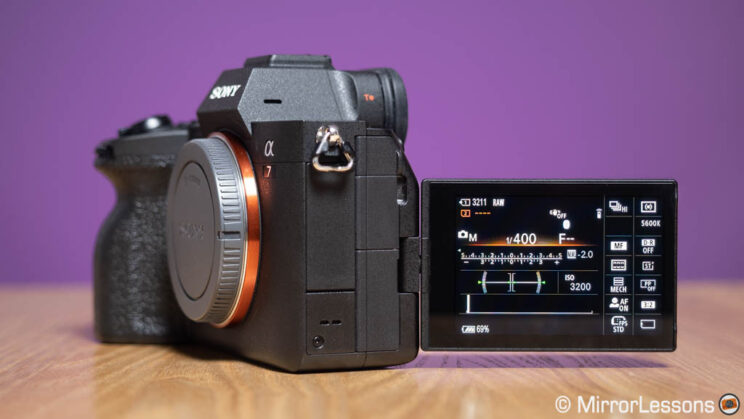
Regarding the screen movement, the Sony a7R V’s LCD has a multi-angle slide-to-open functionality. When operating, the same tiltable option is still found on the Sony a7 IV, but with limits to a vari-angle monitor. The 4-axis multi-angle LCD found on the a7R V allows users greater flexibility when composing.
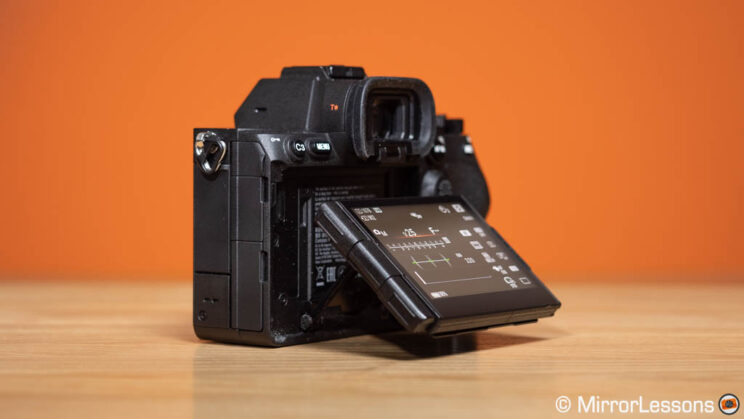
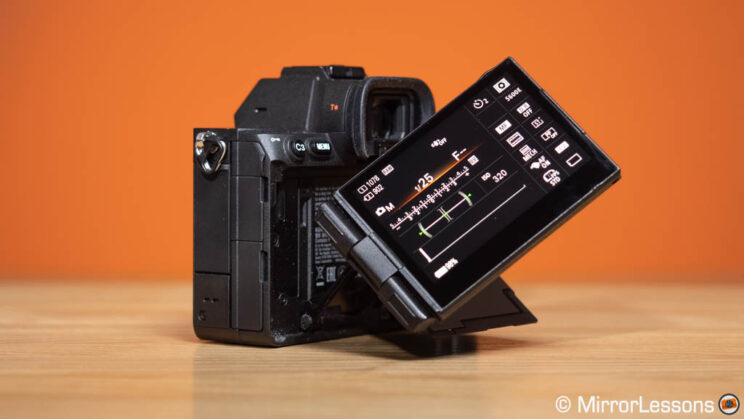
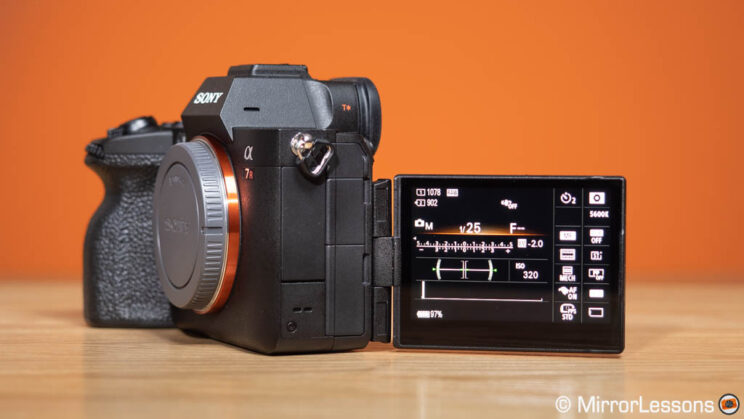
Sharing the same viewfinder as the a1, the Sony a7R V has a built-in 9.44 million-dot QXGA Electronic View Finder. With this 0.64-type EVF, users obtain a 0.90x magnification with a maximum of 120fps and a 25mm eye-point.
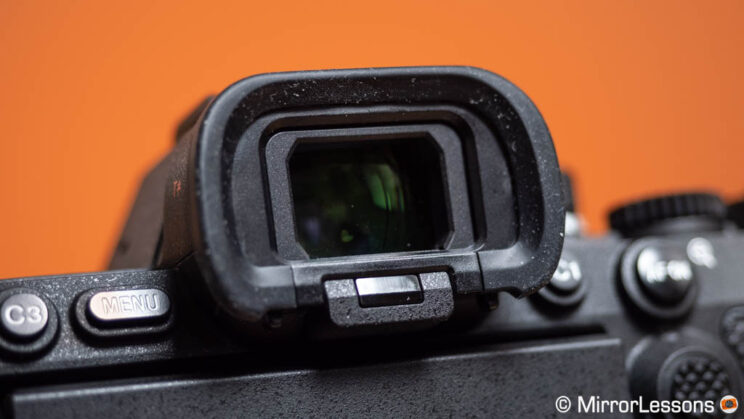
In comparison, the Sony a7 IV features a smaller 3.68 million-dot EVF with a lower magnfication.
EVF
a7 IV
a7R V
Resolution
3.68M dots
9.44M dots
Size
0.5-in OLED
0.64-in OLED
Magnification
0.78x
0.90x
Max. Frame Rate
120fps
120fps
Eyepoint
23mm
25mm
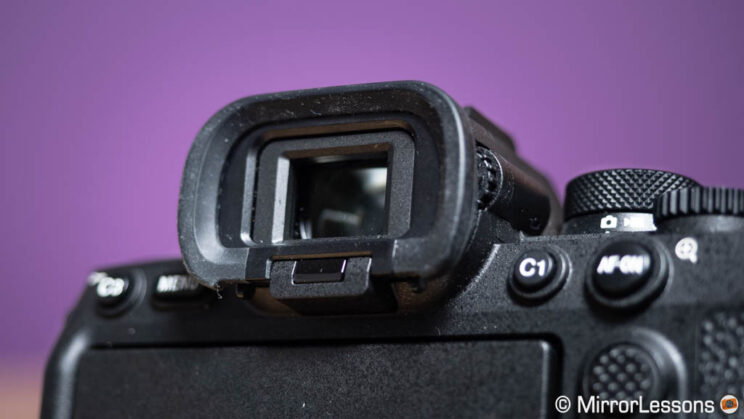
7. Camera Operation
In terms of operation, on the surface, most of the functionality is the same between the two cameras. They share the fourth generation design, the dimensions are practically identical and all the physical controls (buttons, dials, joystick) are equal.
They both offer dust and moisture resistance, but the A7R V is a bit heavier.
- a7R V: 131.3 x 96.9 x 82.4 mm, 723g
- a7 IV: 131.3 x 96.4 x 79.8 mm, 658g
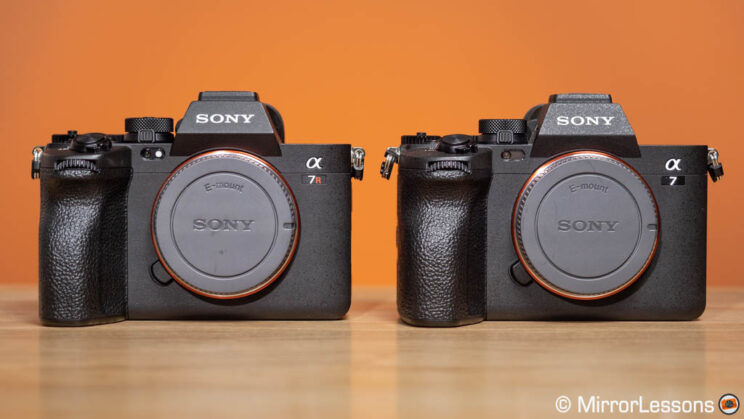
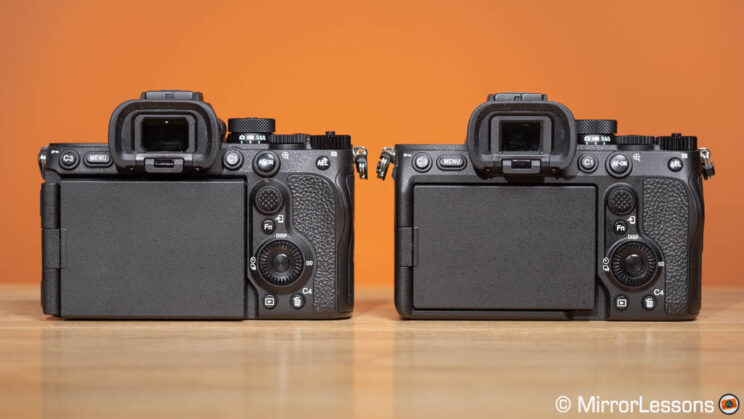
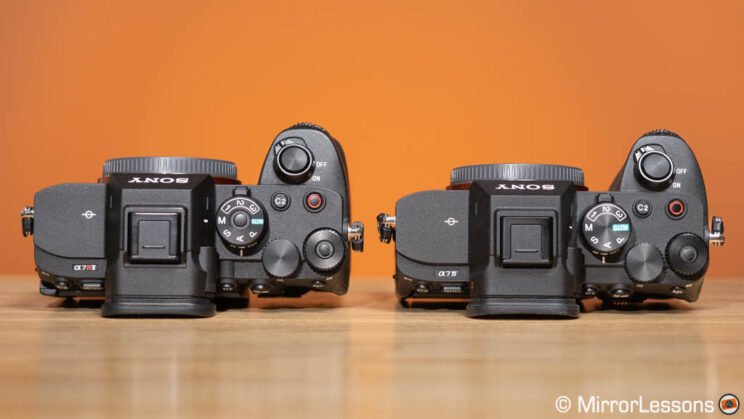
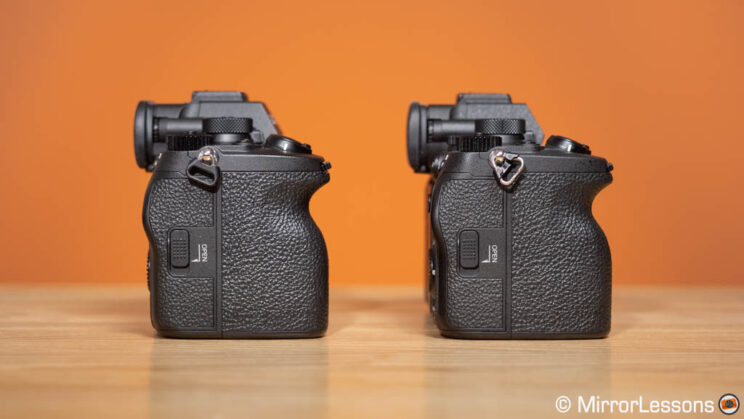
Concerning the ease of use, the only thing to note is the new Main section on the Sony a7R V menu, which is basically a shooting setting list that can be accessed quickly. This addition (coming from the FX3/FX30 cinema line) minimises the menu experience to a matter of seconds, allowing users to find a setting intuitively through larger touchscreen buttons.
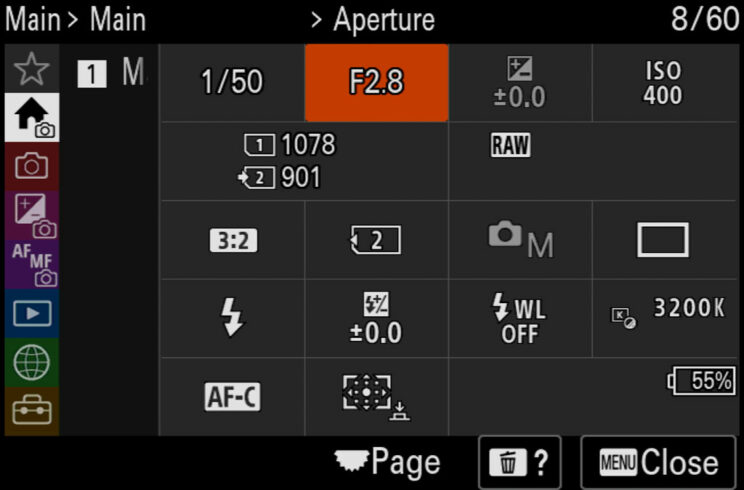
While on the subject of operation, it’s worth mentioning a stand-out feature on the Sony a7R V – the new anti-dust system that starts 70,000 cycles per second to effectively remove dust and particles from the imaging sensor.
8. Storage and Buffer
Enhancing the capabilities of the new Sony a7R V are its two hybrid memory card slots, which can accommodate CFexpress Type A or SD cards (while the a7 IV features one hybrid slot and one SD-only slot). Both types of cards are compatible with most video recording formats, but the faster writing speed of CFexpress helps in clearing the buffer more quickly.
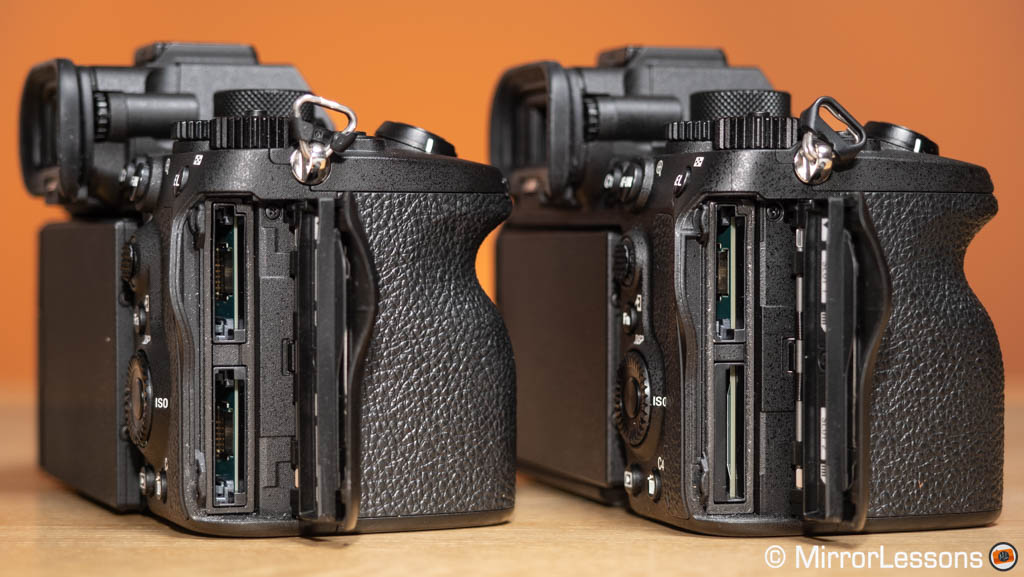
Both models are capable of shooting at a maximum speed of 10fps. It’s important to note that this speed applies to JPG and Compressed RAW files. If you opt for Lossless Compressed RAW or Uncompressed RAW, the speed decreases to approximately 6.7fps for the A7R V and 6fps for the A7 IV.
In terms of buffer capacity, both cameras maintain a consistent speed for the initial 30 seconds when using a CFexpress card (and they can keep going for longer). Surprisingly, with a UHS-II SD card, the A7R V outperforms the A7 IV, achieving a remarkable 10 seconds at full speed, which is twice as long as what the other camera can achieve.
9. Connectivity and Workflow
The Sony a7R V can transfer at double the speed of the Sony a7 IV through the 2×2 MIMO (often referred to as 2T2R). The way 2×2 MIMO works is by transferring data via two dedicated antennas, which establish up to two streams of data with the receiving device, hence why it is twice as fast.
Other type of connections are the same on the two cameras and include:
- USB-C with 10Gbps of speed
- Wired LAN via (USB C adapter required)
- USB Tethering with compatible Xperia smartphones
- Plug-and-play webcam mode (no extra plugins required)
- 2.4GHz Bluetooth
- Full size HDMI output
The A7R V also features a flash sync port.
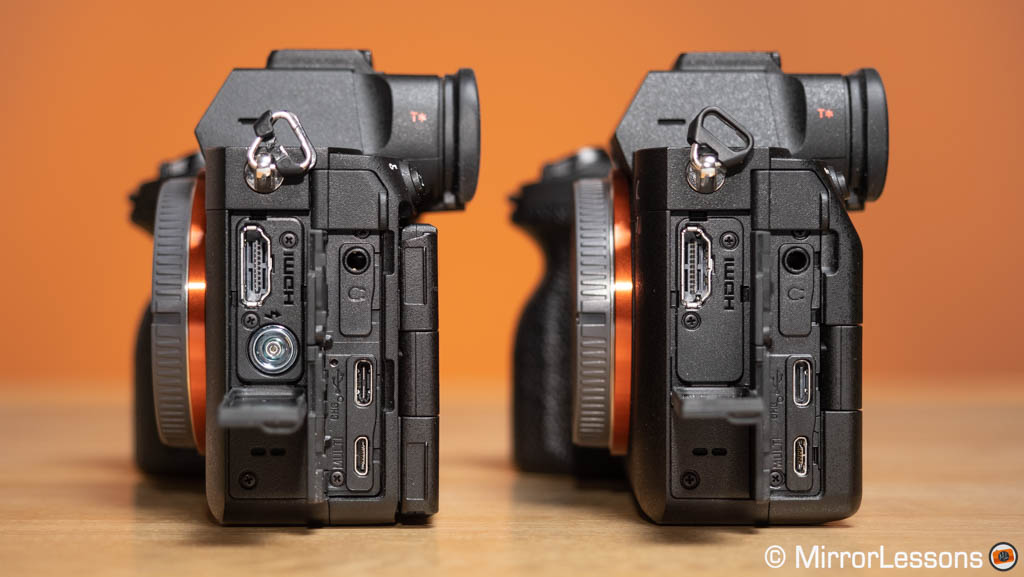
10. Price
The a7R V can be found for the retail price of $3900, £4000 or €4500 (body only).
The a7 IV is less expensive and is available for $2500, £2400 or €2700 for the body only once again.
Prices as of early June 2023.
Conclusion
Other Comparisons to check
A7 IV vs A7R IV
A7R IV vs A7R V
The Sony a7 IV stands as a strong contender for your next camera, offering a versatile range of features at a more affordable price. It provides exceptional image quality, a plethora of advanced video settings, and an impressive autofocus system that performs superbly across various genres.
However, if resolution is your primary concern, the Sony a7R V should not be overlooked. With its stunning 61MP sensor, it produces incredible results for landscape and studio work. Wildlife photographers will also appreciate the cropping capability offered through the APS-C mode or in post-processing. Additionally, the camera boasts a state-of-the-art viewfinder and arguably the best articulated LCD monitor to date.
The autofocus improvements are intriguing and show great promise. While I cannot comment on its performance for portraits, events or motorsports, in bird photography, the results are mixed. The system excels with static birds, particularly when they are in unfavorable positions or appear small in the frame. However, when it comes to capturing fast-action shots of birds in flight, the new AI-powered system has yet to demonstrate a noticeable advantage compared to other E-mount cameras.
Regarding video capabilities, the a7R V has a significant advantage when it comes to 8K recording. However, if 8K is not a requirement, the a7 IV delivers better quality in 4K, especially when working in full-frame mode.
Reminder: the links below are affiliate links. If you decided to buy something after clicking the link, we will receive a small commission.
Check price of the Sony A7R V on
B&H Photo
Check price of the Sony A7 IV on
Amazon | Amazon UK | B&H Photo | eBay
About the co-author
Leigh Diprose is a business owner and full-time writer in the imaging industry. His knowledge of photography, cameras, lenses, lighting, audio, film, printing, cinematography, and accessories has amassed over a 20-year career. Published work and contributions can be seen across the internet, including notable brands including, PetaPixel, Fujifilm, ShotKit, Adorama, Canon, Arcatech, Videvo, SmallRig, ATLI, Light Stalking, Lucky Camera Straps, and many imaging manufacturers and leading retailers in over 14 countries.

